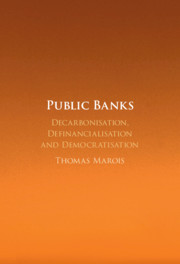- Anthropology & Archaeology
- Behind the Scenes
- Business & Economics
- Cambridge Now
- Cambridge Reflections: Covid-19
- Climate Change
- Computer Science
- Earth & Life Sciences
- Higher Education
- History & Classics
- Into the Intro
- Language & Linguistics
- Law & Government
- Literature
- Mathematics
- Medicine
- Multimedia
- Music, Theatre & Art
- Philosophy & Religion
- Podcast
- Politics
- Psychology
- Science & Engineering
- Sociology
- Uncategorized
22
Apr
2022
Public banks with a green and just public purpose are our best hope
Written by: Thomas Marois

Everyone knows it. We are facing a global environmental crisis of extinction-level proportions driven by carbonizing fossil capitalism. In May 2021 the International Energy Agency (IEA) released it most alarming flagship report, Net Zero by 2050 A Roadmap for the Global Energy Sector. While offering a pathway to reversing carbonization, the Report stresses that existing government commitments fall well short of what is needed to reach net-zero energy-related carbon emissions by 2050. This undermines our chances of holding the global temperature rise to 1.5 °C.
A 2022 Intergovernmental Panel on Climate Change (IPCC) Report puts it starkly:
Any further delay in concerted anticipatory global action on adaptation and mitigation will miss a brief and rapidly closing window of opportunity to secure a liveable and sustainable future for all. (very high confidence)
The IEA argues, and the IPCC agrees, that we need a dramatic shift to proven alternative, clean, and resilient energy sources, like solar and wind. The IEA holds hope for new innovations in bioenergy and carbon capture. It underscores that we have no room left for new fossil fuel and coal investing. It notes that we must change how we behave and reproduce ourselves.
But how to finance this energy, indeed societal, transition at the pace and scale required? On this the IEA and IPCC Reports are relatively silent on detail.
Financial business as usual is not working. The Financial Times warns of the ‘fallacy of ESG investing’: win-win voluntary ‘CSR’ strategies are at best illusionary, and downright ecologically damning at worst.
Civil society organisations fear banks are fuelling climate chaos. Since the 2015 Paris Agreement, sixty of the world’s largest banks have channelled $4.6 trillion into supporting fossil fuels. Given the current, energy crisis, this is likely to spike in 2022.
What are our options? How are we to get finance out of carbonising energy and into decarbonised sources – at the right amounts, times, and places? And how to do so in ways that are fair and inclusive, as emphasised by IEA Executive Director Fatih Biral?
One viable option is public banks. Public banks include retail, developmental, and universal banks located with the public spheres of states via ownership, mandate, public representation, or some combination. They are nowhere without their problems and pitfalls. However, public banks offer our best fighting chance at financing the changes needed to confront the global climate crisis, and to do so justly. What substantiates this claim?
First, there is sufficient existing public banking capacity to take the lead on climate finance now. There are more than 900 public banks worldwide that, combined, hold more than $49 trillion in financial assets.
Second, public banks already punch well above their weight in climate finance commitments. Disaggregating Climate Policy Initiative data on overall public and private commitments, public banks provide nearly equal amounts of climate financing as all private banks – despite private banks having four fold the total assets of public banks. Research also shows that public sources of finance “have been playing a pivotal role in stabilizing the investment volume” in renewable energy, smoothing out the instability of private investment patterns.
Third, public banks can, as a matter of political will, be made to rapidly scale-up financial and institutional capacity in response to crises. Public banks’ Covid-19 responses are case in point. The lessons that can be applied to public bank responses to the climate crisis. In the US, this has informed debate around the proposed National Infrastructure Bank. Rather than regulators chasing after private banks that are known to be gaming the ‘ESG’ system, law makers can command existing public banks to reverse global warming and create new ones to do the same.
Fourth, public banks can pursue social equity as a matter of democratic public purpose. The little-known Council of Europe Development Bank functions according to an explicit social mandate. The remarkable Costa Rican Banco Popular y de Desarrollo Comunal is bound by the 2002 ‘Democratization Law’ as it pursues a triple bottom line, the economic, the environmental, and the social. The German KfW has a representative form of democratic governance that spearheaded its own green transformation.
None of this is to say that public banks are immune to problems or do not need to be made better, let alone greener and more just. Public banks are everywhere contested and often contradictory entities. But public banks are also dynamic institutions able to evolve in response to social, political, economic, and environmental grand challenges. If societies give public banks this public purpose, they are our best hope of financing a green and just response to the global climate crisis.
Enjoyed reading this article? Share it today:












Latest Comments
Have your say!